
Download
in PDF Format
Accomac
is all about history and government.
It�s what Kirk Mariner, an Eastern
Shore native who chronicles local history and is the minister of
Williamsburg United Methodist Church, writes in his book, Off 13, the
Eastern Shore of Virginia Guidebook:
|
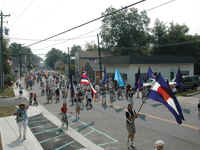
The
annual July 4th Parade has grown tremendously since having only
about 20 participants 37 years ago, but popsicles are still handed
out to everyone on the courthouse green following the parade. |
�It is said that among Virginia�s
old towns only Williamsburg has more historic architecture than Accomac.
Certainly few places in Virginia, and none on the Eastern Shore, surpass
the county seat of Accomack County in preserving handsome buildings from
the past. A Virginia Historic District was created here a few years ago,
and Accomac is so historic that almost the whole town was included in
it.�
Accomac is not about shopping. You can
count on one hand the number of merchants in a town with a population of
529.
Accomac is not about dining. The only
eatery opened in May and closes at 2 p.m. each weekday and remains closed
on weekends. Fishermen sometimes grab a sandwich with their bait and
tackle from the town�s only gas station at the edge of town.
Accomac is one of those towns that roll
up the streets after 5 p.m. when the county officials, lawyers and bankers
leave town. On weekends visitors will walk the tree-shaded streets, admire
the pretty gardens, and enjoy a picture-perfect town that exudes history.
Quite often, they are holding
Mariner�s book and following suggestions for a walking tour of the town.
Their conversations are rarely drowned out by any passing traffic.
The site of Accomac, spelled without the
�k� on the end, was chosen for the county seat of Accomack in the
1600s. However, when the town was established by the state in 1786, it was
named Drummondtown after a man who owned most of the land. It wasn�t
until the late 1880s the town was officially renamed Accomac, after
attempts failed to move the county seat to Parksley, where the railroad
was creating a bustling town.
|
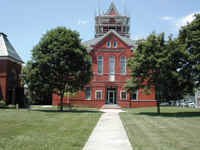
The
Courthouse, erected in 1899, replaced an earlier one built on the
site in 1756. |
Even a Union soldier, among the troops
who occupied Accomac during the Civil War, wrote in a local paper that
Accomac was a �one-horse town.�
Floyd Nock, a noted architectural
historian who died in 1997, used that phrase in the title of his book,
Drummondtown, A One Horse Town, Accomac Court House, Virginia. Nock, who
grew up near Accomac on Folly Creek, had an office in town and wrote two
other books on his beloved Accomac.
One book, What the Saturday Evening Post
Missed, is full of anecdotes and stories passed on and compiled by Nock in
an easy-to-read manner. The title is based on a story about a young,
aspiring Saturday Evening Post writer sent by his editor to visit Accomac
to seek out interesting people for his stories.
|
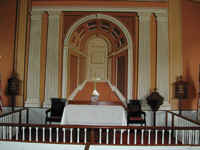
Built
in 1838 with bricks from a 1767 structure at a site outside of
town, St. James Episcopal features an excellent example of pointed
decoration in a form called "trompe l'oeil." This
illusionistic style deceives the eye with its painted columns,
pilasters, paneled hallways and doors that are actually fakes
painted on a flat surface. |
When he saw some men sitting on a bench
in front of the courthouse, he asked them where he could find some
�characters.� They pondered awhile, wanting to help him, and one man
finally said, �Son, you must be looking for Eastville. It�s 30 miles
farther down Route 13.� The reporter took off, not knowing he was
speaking to the characters he was seeking and leaving a wealth of
information behind.
Today�s mayor of Accomac is regarded
as a �character� by some. Brooks �Butch� Allen became mayor seven
years ago after he went to a town council meeting because a neighbor
complained about a portable toilet on a lot he owned. Allen gladly removed
it, but felt the neighborly thing to do was to ask him first before going
to the town council.
|
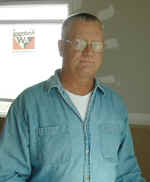
Butch
Allen was reelected mayor of Accomac in May. Less than 100 of the
town's 529 residents voted. Allen said he would have won in his
first attempt as a write-in candidate if they had counted the
votes that said "Butch." |
He unsuccessfully ran for mayor as a
write-in candidate in the next election. �They told me I would have won
if they could have counted the votes that said �Butch,�� the
nickname he had been known by since growing up in Accomac.
When the then-mayor resigned in
mid-term, the town asked Allen to become mayor because he continued to
attend council meetings and showed interest in town matters.
Reelected in May with 43 votes � four
more than his opponent � Allen says his priorities are to see that trash
removal is done in a timely manner and to keep taxes low. He says the
typical attendance of five people at most council meetings is outnumbered
by the six council members. �When we get a really hot issue, there might
be 15 or 20 people attending,� says Allen. He doesn�t say what a
�hot� issue is.
Allen, who is a self-employed
construction worker, is now building a house at the edge of town for his
daughter, her husband and their three children. There is no town hall, and
thus no need to keep office hours. Accomac is different from most towns in
that it does not need a police force because the county sheriff�s
department is headquartered there. It also does not have a fire company,
depending on nearby towns including Tasley, Onancock and Parksley to
respond to emergencies.
One of the most important events in
Accomac�s history was a fire. It was in 1921, and it was fought with a
bucket brigade and a couple of fire extinguishers that were no match for
the flames that reached uncontrollable proportions. When the toll of the
fire was finally tallied, 14 buildings had been destroyed.
|

French
Coleburn, pictured here with his wife Dachia, has lived in his
house all of his 92 years. He recalls the fire of 1921 that
destroyed a large part of the town. |
�I stood on the sidewalk and watched
the old hotel burn down,� said French Coleburn, now 92. He was a boy of
eight at the time and watched his father and other men try to save as much
as possible before the building crumbled. �That fire was a big blow to
the town. Some families lost their business and had a hard time
recovering.�
Coleburn has lived all his life in the
same house on Courthouse Avenue, but around him he has seen people come
and go. �There hasn�t been a lot of new construction in town. This
house is over 100 years old, but I�ve seen a lot of houses sold a few
times. I used to know everyone who lived in town, but not anymore.�
Coleburn can tick off the names of
several grocery stores that once operated in town, recalls a pool hall
where men congregated, and points out where a bank, a drugstore and even a
blacksmith shop once stood.
�When I grew up there were no stone
roads in town ... There were a few cars � nothing like the traffic today
� and there were enough horses to keep a blacksmith in business,� said
Coleburn.
Coleburn�s father worked at the
Peninsula Enterprise, a newspaper founded by the Edmonds family in 1883 in
Accomac. �He made $15 a week, but that was enough then to feed a
family.�
The town also once hosted the only high
school in Accomack County for African-American students. The school was
named for famed local educator Mary N. Smith in 1934, after she led a
fund-raising drive that lasted over a decade. A new Smith high was
completed just outside of town in 1953, and the structure became a middle
school when the schools were integrated in 1970. The middle school closed
in June, although Smith�s family and graduates of the school want it
converted to a museum or multi-cultural center.
|
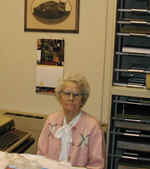
Pearl
Lilliston has been working in the clerk's office since 1939. For
many years her cat, "Judge," remembered in a portrait
above her desk, would sleep on her desk. The courthouse records
are the second oldest continuous records in the country. Only
those in neighboring Northhampton County are older. |
Pearl Lilliston doesn�t remember much
about the great fire of 1921. She was only seven at the time. But Miss
Pearl, as most know her, has worked in the busy court clerk�s office
since 1939. Now 90, she still works three days a week, usually leaving
shortly after lunch.
�There was a time I did it all,�
says Lilliston, �everything from indexing, typing, recording deeds and
whatever else that needed to be done.�
To get a measure of the continuity in
the clerk�s office, Lilliston has worked for only five clerks and five
judges in her 65 years in the office. The office has the second oldest
continuously kept records in the country � second only to those in
neighboring Northampton County.
A fixture who is no longer in the
clerk�s office, but remembered in a portrait that hangs above Miss
Pearl�s desk, is �Judge,� a cat who slept on her desk each day.
Judge was profiled in the local newspaper and was adopted by lawyers and
others who visited the clerk�s office each day. He died several years
ago.
Jack Mason, who left Accomac after
college and was doing public relations work in Phoenix when he made a
decision to return home and start a real-estate business in 1967, recalls
the excellent education afforded at the old Accomac High School. The last
graduating class was in 1953, and then the building served as an
elementary school, and then primary school before closing in 1998.
The school is now vacant while
elementary students are bused a few miles outside of town to a school
bearing the Indian name, Accawmacke.
�In my time, we had students go on to
become a journalist at the New York Times, an advertising executive at
NBC, and an accountant with DuPont. The teachers would work with students
after school and have students come by their house on weekends. They
really prepared you for college.�
|

Vince
Taylor, one of the few merchants in Accomac, moved his marine
business here in 1981, and says he likes the quiet nature of this
town. |
Vince Taylor, who owns Sandpiper Marine,
moved his business to Accomac in 1981. �We�re off the beaten path
here,� says Taylor, �but we do get business from people who come to
see the historic buildings in town. Accomac is a quiet, friendly town, and
we�re happy to be here.�
Those historic buildings include the old
courthouse, erected in 1899, and the debtor�s prison, erected in 1783.
The debtor�s prison is listed in the National Register of Historic
Places. There�s the courthouse, erected in 1899, replacing an earlier
one built on the site in 1756. Across the street from the courthouse is a
sign marking the birthplace of Henry A. Wise, the only Eastern Shoreman
elected governor of Virginia.
Back Street, considered by many to be
the loveliest on the Eastern Shore, includes several homes whose origins
date to the 1700s, and others from the 1800s that typify the �big house,
little house� style of architecture so prevalent on the Eastern Shore.
One of the most interesting attractions
in Accomac is St. James Episcopal Church. Built in 1838 with bricks from a
1767 structure at a site outside of town, the church features an excellent
example of painted decoration in a form called �trompe l�oeil.� This
illusionistic style deceives the eye with its painted columns, pilasters,
paneled hallways and doors that are actually fakes painted on a flat
surface.
One of the biggest events of the year
� maybe the only big event � is the July 4 parade in Accomac. Only
non-motorized vehicles are allowed; thus, it is primarily a bicycle parade
with some strollers and wagons filled with children and either pushed or
pulled by parents.
Now in its 37th year, the parade started
out as a small gathering of maybe 10 children when founded by Joanna
Snyder. And though the parade has become hugely popular and has grown
tremendously, the annual tradition of handing out popsicle sticks on the
courthouse green continues.
Small-town America is never more evident
than when adults and children alike lick their popsicles as the
Declaration of Independence is read followed by some patriotic tunes from
the county band.
The parade, like most everything else in
Accomac, is keeping in the town�s style of doing things just a little
bit slower and quieter than most places.
Bill Sterling is the editor/general
manager of The Eastern Shore News, located in Accomac. He has been with
the newspaper since 1974.